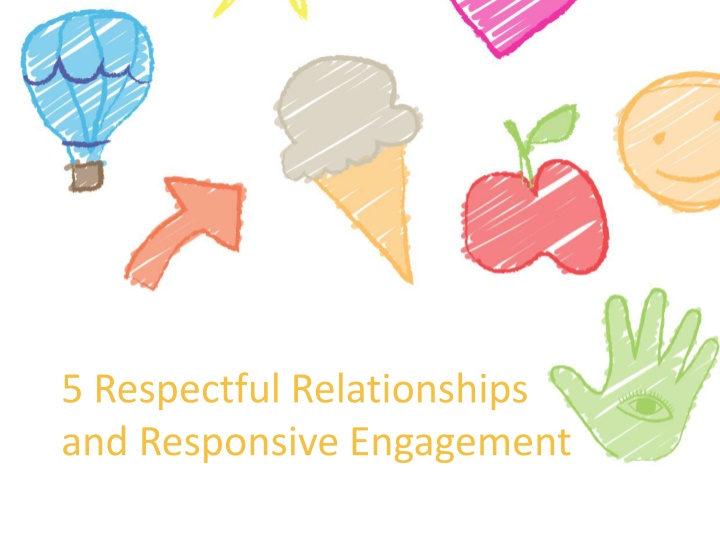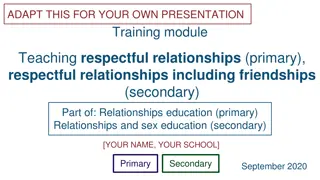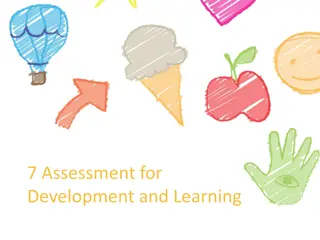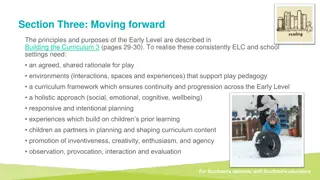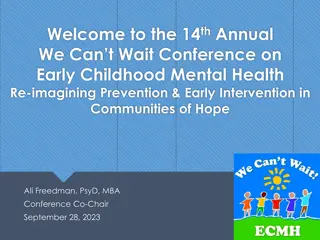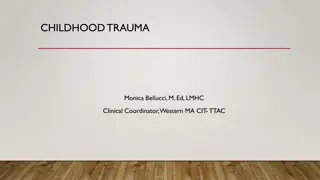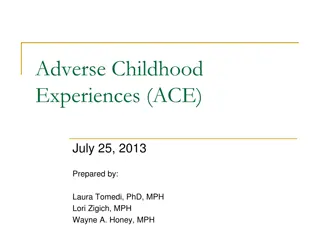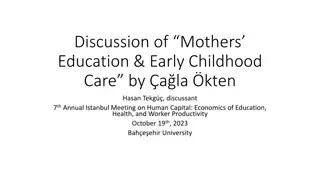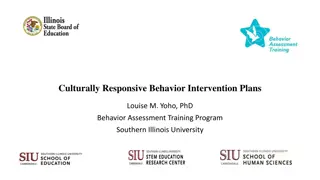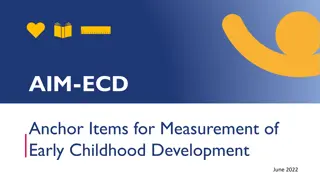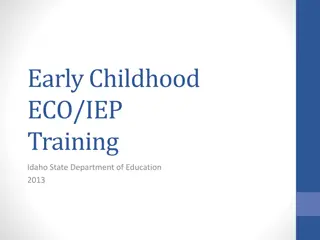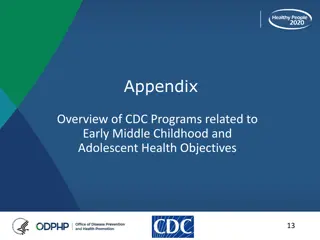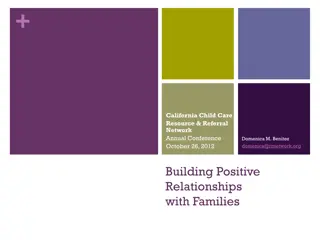Building Respectful Relationships and Responsive Engagement in Early Childhood
Responsive engagement in early childhood education involves building respectful relationships with children and families, emphasizing their strengths and interests. Two case studies highlight the importance of being attuned to children's needs and promoting positive relationships between parents and children. The foundations of early childhood intervention focus on strengths, family support, and collaborative relationships.
Download Presentation

Please find below an Image/Link to download the presentation.
The content on the website is provided AS IS for your information and personal use only. It may not be sold, licensed, or shared on other websites without obtaining consent from the author.If you encounter any issues during the download, it is possible that the publisher has removed the file from their server.
You are allowed to download the files provided on this website for personal or commercial use, subject to the condition that they are used lawfully. All files are the property of their respective owners.
The content on the website is provided AS IS for your information and personal use only. It may not be sold, licensed, or shared on other websites without obtaining consent from the author.
E N D
Presentation Transcript
5 Respectful Relationships and Responsive Engagement
Responsive engagement Builds on respectful relationships and sensitivity to the uniqueness of each child and family Requires understanding that the most effective learning experiences are based on children s strengths, abilities and interests caring presence
attuned engagement Is a characteristic of a responsive relationship Involves alert awareness, being receptive and connected to both individuals and the group and responding accordingly
Case study 1 An educator described her frustration with a child who was very slow to finish morning tea as she had a meeting to attend. She made a few comments to the child about hurrying up, and then she stopped and thought about how the child might be feeling about her obvious frustration and need for a hurried routine that morning. Reflecting in the moment, she remembered that earlier in the morning the children had talked to her about bullying and why they didn t like it. She wondered whether her frustration led to an interaction that did not reflect a commitment to respectful relationships and responsive engagement with children.
Case study 2 A supported playgroup facilitator said: It helps me when I start to feel a tension between focusing my attention on children and on the adults to remember that one of the most important things I can do probably the most important thing - is to promote a strong and positive relationship between the parent or carer and the child. So it s not one or the other my focus needs to be on both. What am I doing to support that parent to see him or herself as a good parent and to see his or her child as an amazing human being who is learning all the time? That s what s important.
Three foundations for early childhood intervention Since the 1990 s early childhood intervention has been built on: emphasising children s strengths and abilities supporting families choices and decision- making actively developing collaborative and supportive relationships between families and professionals
Why are respectful relationships and responsive engagement important? UN Convention on the Rights of the Child (1989) Early Childhood Australia Code of Ethics (2006)
In practice Respectful relationships and responsive engagement occur when professionals: demonstrate cultural competence in their interactions with children and families give priority to warm, respectful relationships between professionals and children ensure that children experience continuity in their experiences and relationships
In practice (cont.) Encourage and support children to have respectful relationships with other children and to teach and learn from each other Interact with children to extend their learning in a variety of ways Listen and respond to children with full attention
Cultural competence Being aware of personal culture, values and beliefs Acknowledging both similarities and differences Having positive attitudes to differences Gaining knowledge of different cultural practices and perspectives Developing cross-cultural communication skills Understanding that culture relates to many things
Case study 3 A teacher in a kindergarten with an indoor-outdoor program (a program where there is supervision both indoors and outdoors at the same time) spoke about asking a child to go outside and be with a child who wasn t coping that morning with the inside activities. He was being disruptive and having difficulty regulating his own behaviour. She knew that he would calm down outside, away from the group. She also knew that the accompanying child not only would be a calming influence but also that he would be pleased to be asked to help. She added that she could not have done this at the beginning of the year before she knew the children well.
Children and continuity in their experiences and relationships The younger the child the greater the importance of continuity between their experiences in the family and early childhood settings When children s experiences and relationships are consistent and somewhat predictable they learn what to expect, can predict what will happen, and as the new setting and relationships become more familiar, they relax, explore and take risks in their learning
Children and continuity in their experiences and relationships (cont.) Continuity is more likely to occur when professionals and families communicate openly Professionals learn about families and children through conversations and discussions with them
Case study 4 An educator working with toddlers in a child care centre spoke about the centre s system of allocating new children to a particular educator from the beginning, so that they can form a strong relationship. They are mindful that this relationship acts as a foundation for the child to form relationships with other educators, in much the same way that it happens when family members stay with their child when they first start at the service and help their child form a relationship with an educator.
Case study 5 Three eight to ten-year-old boys in an after school care program wanted to spend all their time on the basketball court. The educator didn t discourage this, but when she noticed several younger children spending a lot of time looking on, she asked the older children if they would teach the younger ones to play basketball. This evolved into a project that went on for weeks and included the older boys petitioning the school to put up a lower hoop. Eventually more and more younger children took an interest, resulting in enough children to make up two small teams. The older boys took increasing interest in their roles as teachers, and seemed genuinely proud of the skills the younger children were developing. They recommended to the educator that when spring came they d like to do the same thing with cricket!
Smooth sailing? Relationships between children are not always smooth and many schools use specific programs such as restorative justice, tribes and circle time to promote children s capacity to solve relationship and friendship issues without over- reliance on adults These programs are designed to teach children respectful ways to deal with conflict, as well as to build children s social competence and resilience
Extending childrens learning Knowing children in the context of family, culture and community Building on children s strengths, abilities and interests Having conversations and interactions with individual children in ways that have meaning for the children Reflecting on children s perspectives and discussing those reflections with children Teaching intentionally Setting up learning environments that support children s sustained engagement with materials, each other and adults and that promote collaborative learning
Extending childrens learning (cont.) Encouraging children s communication by paying careful attention, showing interest, giving time and responding in meaningful ways Encouraging families to maintain the child s first language at home and using words from that language in the early childhood setting Using assisted communication resources, for example a photo of the child participating in an everyday routine such as hand-washing Working with early childhood intervention specialists
Shared, sustained thinking Working collaboratively with children by sharing ideas to extend their learning so that children become confident, involved learners and their ideas or skills are recognised and encouraged Educators sustain children s thinking in different ways such as conversations, questions, suggestions, clarifying ideas, or thinking aloud I wonder what would happen if ?
